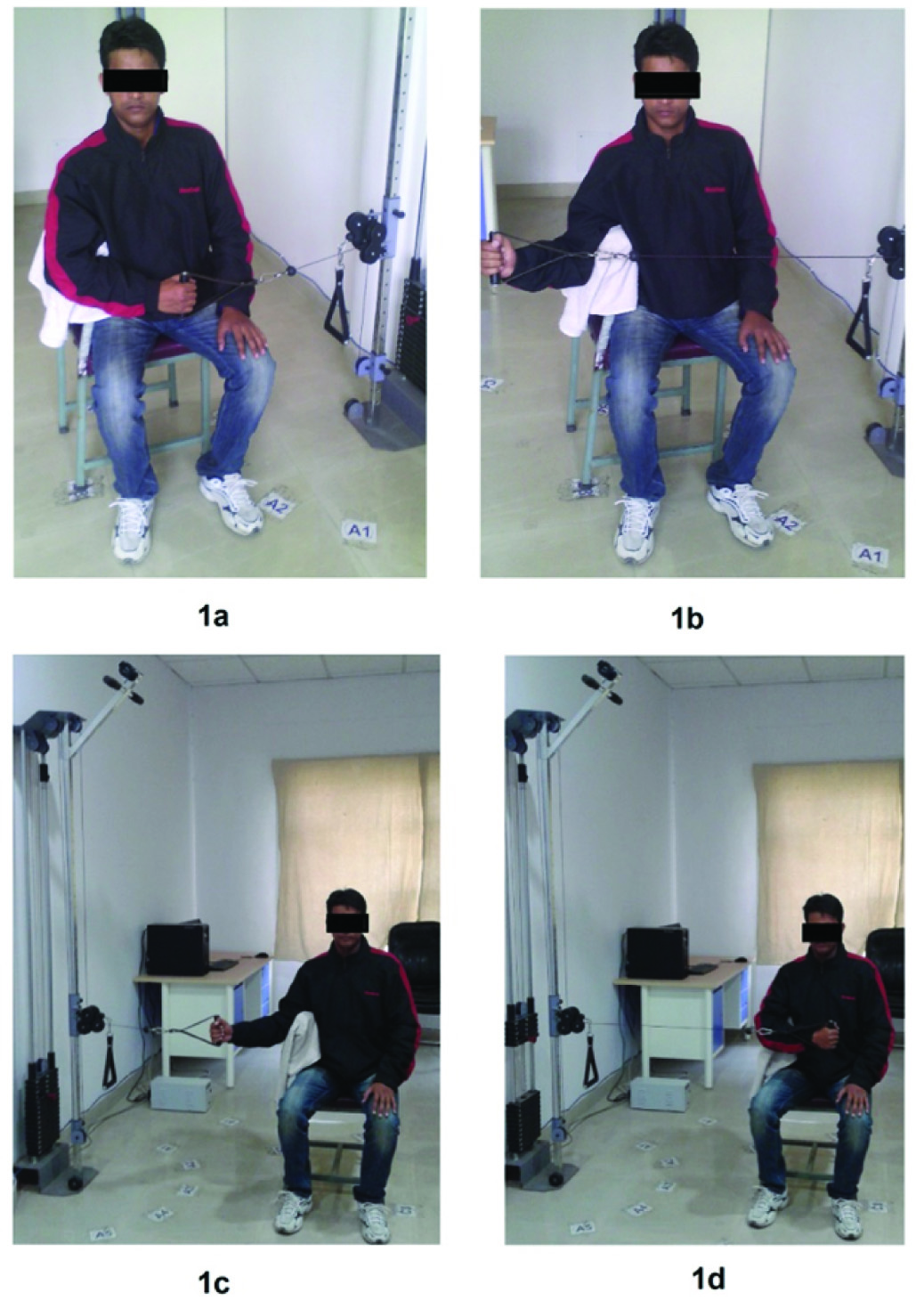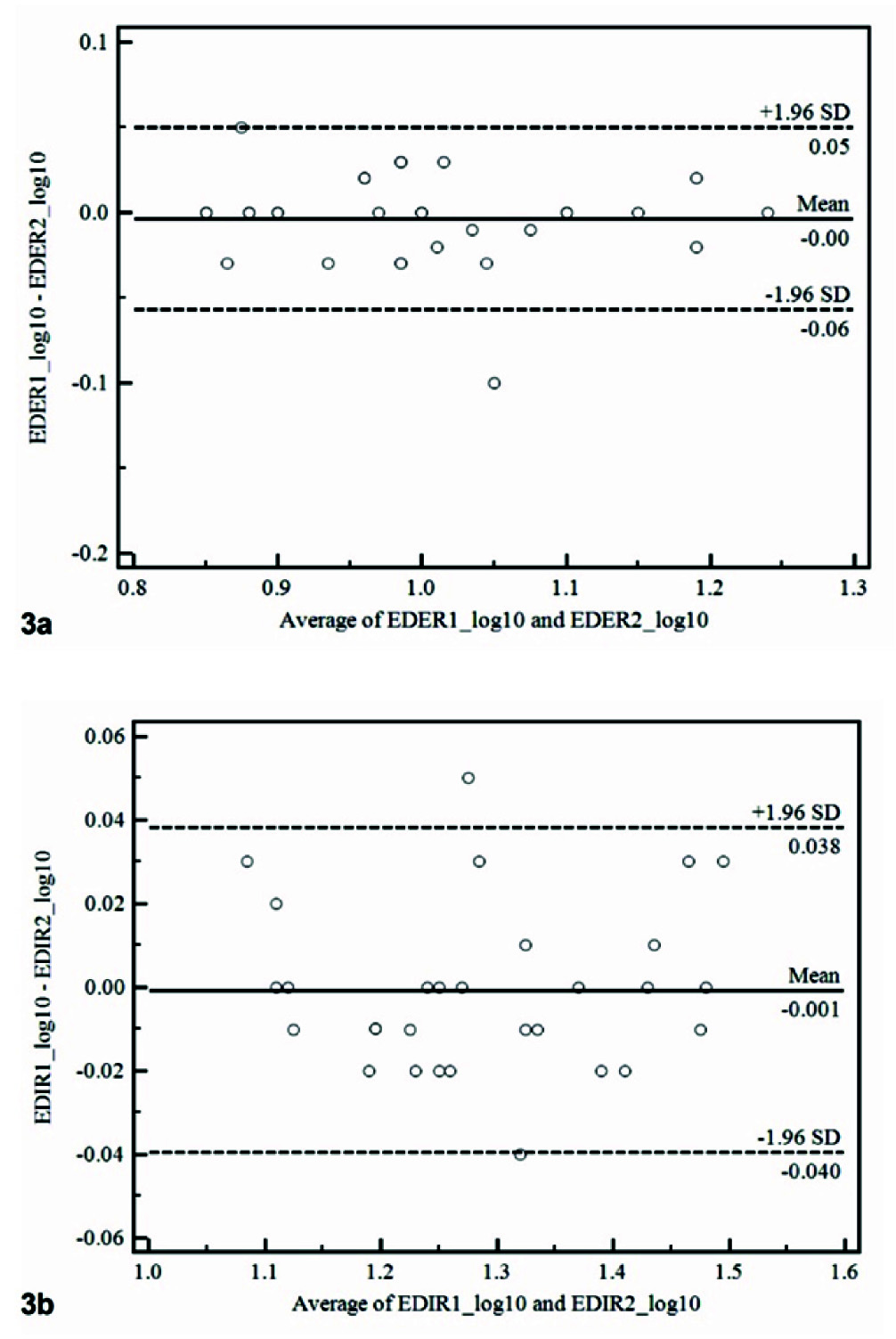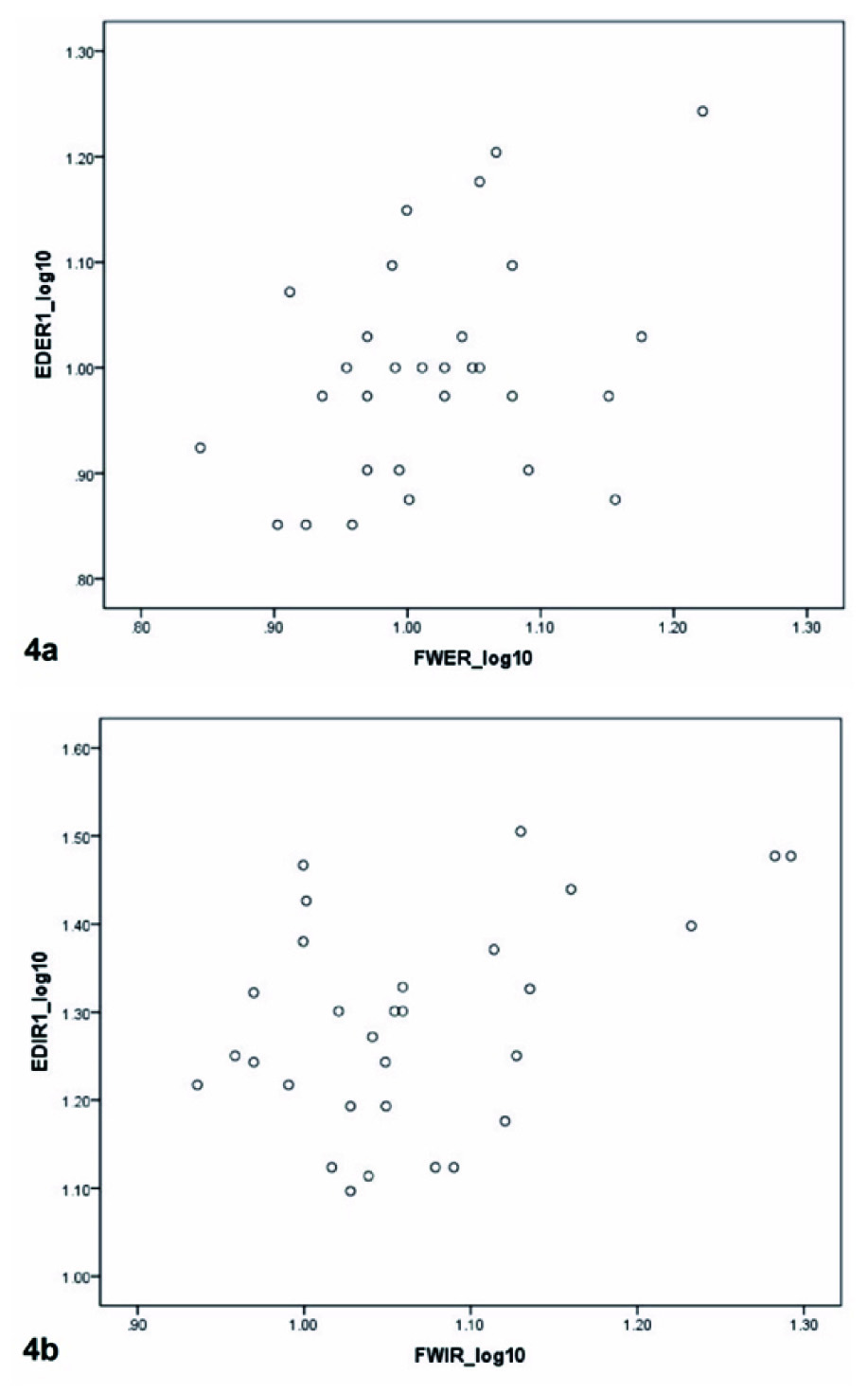Volleyball is one of the most popular sports in the world and has been a part of the Olympic Games since 1964 [1]. It involves repeated forceful arm actions as in other sports such as tennis, baseball, javelin and swimming and produces a high incidence of shoulder injury [1]. Rotator cuff muscle lesion or related injuries are the main shoulder injuries in this sport [2]. Vigorous repetitive movements lead to accumulated microtrauma as a result of which the injured rotator cuff muscles may lose the ability to maintain a balanced relation with their antagonists. This imbalanced force couple around the shoulder area may aggravate the injuries caused by eccentric overload or may induce secondary shoulder impingement or instability [3]. Both the infraspinatus and teres minor muscles act eccentrically to control the movement of the humerus and provide a stabilizing posterior restraint to anterior subluxation in the acceleration phase during volleyball spike and serve [4]. Internal Rotator (IR) concentric strength correlates well with volleyball spike velocity [5].
A great deal of eccentric load on the shoulder rotator cuff muscles is placed by the ballistic action in volley ball, predisposing them to injury [6]. Shoulder rotator strength ratio is considered an important predictor of shoulder injury, especially, secondary shoulder impingement and instability [7,8]. The aim of checking the muscle strength of external and internal rotators of shoulder is to establish the profiles of shoulder rotator performance, strength ratios, and shoulder mobility of volleyball players.
Different tools for objectively measuring muscle strength are isokinetic testing, hand-held dynamometry, 1RM testing [9,10]. Reliability and validity of muscle strength testing by isokinetic dynamometers, Hand-held dynamometers and 1RM calculation by free weight system are well documented [9–12].
The EN-TreeM (proprietary product of M/s Enraf Nonius B.V., The Netherlands) is a new dynamometer for evaluation of dynamic muscle strength. It consists of a pulley device with weight stacks as resistance load (gravitational load) and allows both mono-and multi-joint movements. The EN-TreeM monitors the relative vertical displacement of the weight stacks (resolution: 0.5 mm, sample frequency: 100 Hz) [13]. This position signal is sent to a PC where a software package calculates variables like displacement, velocity, force, power and work. This machine is widely used for quantifying muscle strength [14–17] and is also used for strength training. As per our knowledge, reliability and validity of EN-TreeM dynamometer is not known till date.
The purpose of this study was to establish reliability and validity of EN-TreeM dynamometer for the measurement of shoulder rotators strength in volleyball players.
Materials and Methods
This cross-sectional study with a test-retest design was carried out among collegiate volleyball players from Jamia Millia Islamia, New Delhi, India. The duration of the study extended from September 2014 to February 2015.
Subjects
Thirty trained male volleyball players (mean ± SD age 21±1.8 years, height 1.7± 0.7m, weight 69.8±13 kg and BMI 23.1±3.7) training for over a year were recruited. Subjects with a history of surgery, fractures, instability or pain and restrictions of movement in the shoulder joint were excluded. The study was approved by the Institutional Ethical Committee of Jamia Millia Islamia, New Delhi. Subjects who met the inclusion and exclusion criteria were selected for the study.
Equipment and its Working
The EN-TreeM system is a Windows-linked stack-weight isoinertial machine which can be used to assess the efficiency of movement and strength in both testing and rehabilitation settings. The system works on a single or double wire pulley which is connected to a weights-stack system section and is based on the principle of rope-brake dynamometer. Various movement patterns are executed by Upper and lower limbs when testing subjects. The computer allows for graphical comparisons of different sides of the body and also for test/retest protocols. The EN-TreeM allows an increase of the weight from 0.25 to 24 kg in 30 small steps. The EN-TreeM accurately determines position, velocity, force, power and work and can be used for mono-articular movements as well as complex displacements.
Testing Procedures
Calculation of estimated 1RM (one repetition maximum) for shoulder internal and external rotators in volleyball players was done using the dominant arm. On day 1, the subjects were tested for estimation of 1RM using free weights and EN-TreeM dynamometer. A five minute rest was given between these two tests. On second testing day i.e. after 48 hours, the subjects were asked to perform the 1RM with EN-TreeM dynamometer in order to establish test-retest reliability of EN-TreeM dynamometer.
Testing by Free Weight
To estimate 1RM for shoulder internal rotators (IR) using free weight, subjects were placed in supine lying with the dominant arm at 90° of shoulder abduction, 90° of elbow flexion and pronation such that forearm was perpendicular to trunk and palm of hand faced towards feet. Warm-up load was given for shoulder internal rotators. After 5 min rest, the warm-up load was slightly increased and subjects were asked to perform external rotation (so that internal rotators work eccentrically) in full range with as many repetitions as possible. If the subject performed greater than 15 repetitions, again 2-3 min rest was provided followed by the same procedure with a slightly higher load (≥1kg). To estimate 1RM for shoulder external rotators (ER) using free weight, subjects were in supine position and dominant arm at 90° shoulder abduction, 90° elbow flexion and pronation such that forearm was perpendicular to trunk and palm of hand faced towards feet. Subjects performed shoulder internal rotation (so that external rotators work eccentrically). Then 1RM was estimated using Epley’s equation: [18]

RM Estimation by En-TreeM
To estimate 1RM of shoulder rotators using EN-TreeM dynamometer, positioning was done according to Newsam et al., [19]. External rotators were tested with the subject’s non tested shoulder adjacent to the pulley. The tested arm placed in maximum internal rotation and 900 elbow flexion. A successful repetition was considered when full external rotation was observed with an isolated movement of shoulder rotation without compensatory motions of the shoulder, scapula, elbow, or trunk [Table/Fig-1a&b]. Internal rotators were tested with the test shoulder adjacent to the pulley. The upper arm was positioned alongside the trunk, with 90° elbow flexion and maximum shoulder external rotation. A repetition was considered successful when full internal rotation was achieved without observed compensatory motions of the shoulder, scapula, elbow, or trunk [Table/Fig-1c and d]. After completing the repetitions, 1RM was estimated using the software of EN-TreeM dynamometer. The pulley rope was adjusted according to the subjects’ arm size so that there was no slack and minimum tension in the pulley rope during the starting position of both movements.
(a) Starting position of external rotators One RM estimation using EN-TreeM dynamometer; (b) End position of external rotators One RM estimation using EN-TreeM dynamometer; (c) Starting position of internal rotators One RM estimation using EN-TreeM dynamometer; (d) End position of internal rotators One RM estimation using EN-TreeM dynamometer.

Statistical Analysis
Data were analyzed using SPSS version 21. The Shapro-Wilk test was used to verify the normality of variable distribution and the data was log transformed. Interclass correlation coefficient (ICC2,1) and paired t-test were employed in each group to determine the test-retest reliability. The ICC values were interpreted using the benchmarks suggested by Menz et al., (2004): ICC > 0.75 excellent reliability; 0.40 - 0.75 fair to good reliability; and < 0.40 poor reliability [20].
To determine the internal consistency of the measures, Cronbach’s Alpha was calculated for shoulder rotators. It normally ranges between 0 and 1. George and Mallery (2003) provide the following rules of thumb: “Cronbach’s Alpha ≥ 0.9 Excellent, ≥ 0.8 Good, ≥ 0.7 Acceptable, ≥ 0.6 Questionable, ≥ 0.5 Poor, and < 0.5 Unacceptable” [21].
The concurrent validity of the EN-TreeM dynamometer system was assessed with respect to free weights using pearson correlation coefficient. Pearson correlation coefficient are interpreted as follows <0.30 weak correlation; 0.30 - 0.60 moderate correlation; >0.60 strong correlation [22].
Results
Both shoulder internal and external rotator 1RM estimation measurement by EN-TreeM dynamometer showed excellent reliability on test-retest measurements. The ICC of shoulder external rotators 1RM measurements by EN-TreeM dynamometer was 0.96 while as that of shoulder internal rotators was 0.98 [Table/Fig-2].
Test-retest reliability of shoulder rotators in volley ball players (n=30).
| Muscle group | Initial testMean ± SD | RetestMean ± SD | Pairedt -test | ICC2,1 | CI | F | p | SEM | |
|---|
| t | p | LB | UB | MDC95 |
|---|
| Shoulder external rotators | 9.9± 1.27 | 10 ± 1.27 | 0.619 | 0.541 | 0.96 | 0.93 | 0.98 | 63.24 | <0.001 | 0.24 | 0.66 |
| Shoulder internal rotators | 19.4± 1.31 | 19.5 ±1.32 | 0.541 | 0.593 | 0.98 | 0.97 | 0.99 | 145.36 | <0.001 | 0.18 | 0.49 |
SD: standard deviation; CI: 95% Confidence Interval; LB: lower Bound; UB: upper Bound ICC: Intraclass Correlation Coefficient; SEM: standard error of measurement; MDC95: minimal detectable change at 95% CI.
The Bland Altman plot for limits of agreement for average of EDER1 and EDER2 [Table/Fig-3a] and average of EDIR1 and EDIR2 [Table/Fig-3b] illustrated that most of the data points were within 95% limits of agreement.
(a) Bland Altman plot of agreement between test and retest scores of external rotation (values log transformed for analysis) measured using EN-TreeM dynamometer. The figure reveals that in almost all cases, the difference between the test and retest for external rotation scores was within the 95% confidence interval; (b) Bland Altman plot of agreement between test and retest scores of internal rotation (values log transformed for analysis) measured using EN-TreeM dynamometer. The figure reveals that in almost all cases, the difference between the test and retest for internal rotation scores was within the 95% confidence interval.

The MDC95 for external rotators 1RM estimation measurements by EN-TreeM dynamometer was 0.66, meaning 95% of repeated 1RM estimation measurements by EN-TreeM dynamometer for external rotators will be within 0.66 kg of the original measurement in volleyball players. The SEM for this group was 0.24. For internal rotators the MDC95 and SEM were 0.49 and 0.18 respectively [Table/Fig-2].
Cronbach’s alpha coefficient (α) for the measurements of 1RM estimation for internal rotators was 0.99 and for external rotators was 0.98, both indicating excellent internal consistency.
The estimated 1RM of shoulder rotators with EN-TreeM dynamometer in volleyball players was correlated with 1RM estimation of same muscles by free weights system. The two measurements showed moderate correlation for external rotators (Pearson’s Coefficient, r =0.38 at p =0.03 level of significance) [Table/Fig-4a] as well as internal rotators (Pearson’s Coefficient, r =0.45 at p <0.001 level of significance) [Table/Fig-4b].
(a) Scatter plot of external rotation (log transformed values) measures by EN-TreeM dynamometer (EDER) and free weights (FWER) test results in volley ball players; (b) Scatter plot of internal rotation (log transformed values) measures by EN-TreeM Dynamometer (EDIR) and free weights (FWIR) test results in volley ball players.

Discussion
The results of this study clearly confirm the reliability of EN-TreeM dynamometer in a test-retest situation. Reliable methods of assessing muscle performance are critical to determine an appropriate training load in the rehabilitation setting. Despite the common use of the 1RM estimation test as a reference for training intensity, surprisingly no information has been published about its test–retest reliability when used with machine or free weights. Salem et al., demonstrated very high reliability (ICC > 0.95) for 4 lower extremity tests of the 1RM [23]. The results of present study yielded excellent reliability (ICC for IR=0.98 and ER=0.96) of EN-TreeM dynamometer in estimating 1RM for shoulder external and internal rotators in athletic population. This result was in accordance to previous studies who tested the same muscles using different instruments like Hand-held dynamometer (ICC = 0.98 for shoulder external rotators), Cybex dynamometer (ICC = 0.99 for shoulder external rotators) [24] and elastic bands (ICC = 0.91 for shoulder internal rotators and ICC = 0.77 for shoulder external rotators) [19]. In addition, minimal clinically important difference (MCID) is a significant tool to determine if the change is clinically relevant. To quantify the amount of change in muscle strength that must be observed to be considered to exceed measurement error and variability, the minimal detectable change (MDC95) and standard error of measurement (SEM) were calculated. The results yielded the MDC95 scores for internal and external rotators as 0.49 and 0.66 respectively and SEM was 0.18 and 0.24 respectively.
An important part of 1RM testing is the use of familiarization, to ensure reliability. Previous studies advocate the need for multiple familiarization sessions before assessing maximal strength to avoid an improvement in muscle strength due to improved motor co-ordination or other neural adaptations [25,26]. Further, familiarization process prior to 1RM strength test ensures reliable test results and minimizes learning effects or systematic bias [27,28]. The participants of this study were familiarized with each of the resistance machines by performing warm-up with both free weight and EN-TreeM dynamometer before the 1RM testing. This short familiarization period may be adequate for assessing maximal strength, since our reliability of the 1RM tests were excellent (ICC=0.96) for both shoulder external and internal rotators in both groups.
Standardization of exercise intensity is essential for any resistance-training program. The American College of Sports Medicine recently noted that a lack of standardization of testing procedures contributes to the difficulty of interpreting results of various training regimens [29]. The present study shows that EN-TreeM dynamometer can be an effective method for standardizing training load in a healthy, young adult population requiring moderate to high resistance. The goal-based multiple-RM test can be applied reliably to exercise programs designed for Shoulder muscle hypertrophy by using this dynamometer.
The second aim of the present study was to determine whether estimation of 1 RM testing by EN-TreeM is a valid means to assess muscle strength of the shoulder rotators. To our knowledge, this is the first study examining validity of EN-TreeM dynamometry. To check the validity of EN-TreeM dynamometer, estimation of 1RM for dominant side shoulder rotators by EN-TreeM dynamometer was compared with the gold standard free weight system. Our results showed that measurements of 1RM estimation for shoulder rotators by EN-TreeM dynamometer was moderately correlated (ER: r = 0.38; IR: r = 0.45) with the measurements of 1RM by free weight system. This result of moderate correlation could be due to the different position measurement for each instrument. There were three reasons of taking different positions for the two measurements. First, for free weight system the weight of dumbbells act as resistance and their direction of force will act downwards (gravity) whereas, for EN-TreeM dynamometer, the pulley changes the direction of force of weighting stacks. Secondly, when performing measurement of shoulder rotators 1RM estimation by free weight system in the same position as that by EN-TreeM dynamometer measurements i.e. sitting position, whole shoulder complex musculature would have to work isometrically to hold weight against gravity before the shoulder rotators would perform isotonic work. Thirdly, performing 1RM estimation by EN-TreeM dynamometer in supine lying (as for free weight system), would require larger length of pulley consequently increasing the mechanical advantage by an increase in the length of moment arm.
Limitations
The present study did not examine the inter-tester reliability, so no comments can be made regarding the same. Furthermore, while taking the measurements by EN-TreeM dynamometer the apparent weight lifted is not equal to actual weight due to the mechanical advantage provided by pulleys. It is not known if the machine negates this effect.
Conclusion
The present study findings establish the reliability and concurrent validity of EN-TreeM dynamometer for the quantification of shoulder rotators strength. Based on these findings in volleyball players, EN-TreeM dynamometer can be used with confidence as an instrument for assessing muscle performance (strength). Additionally, it can also be used for monitoring changes due to rehabilitation interventions in shoulder injuries.
SD: standard deviation; CI: 95% Confidence Interval; LB: lower Bound; UB: upper Bound ICC: Intraclass Correlation Coefficient; SEM: standard error of measurement; MDC95: minimal detectable change at 95% CI.